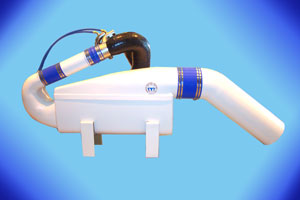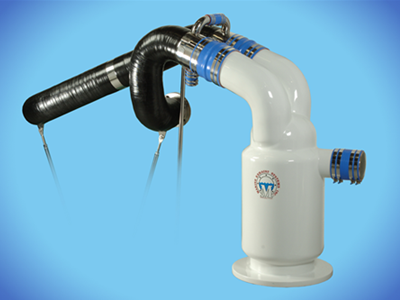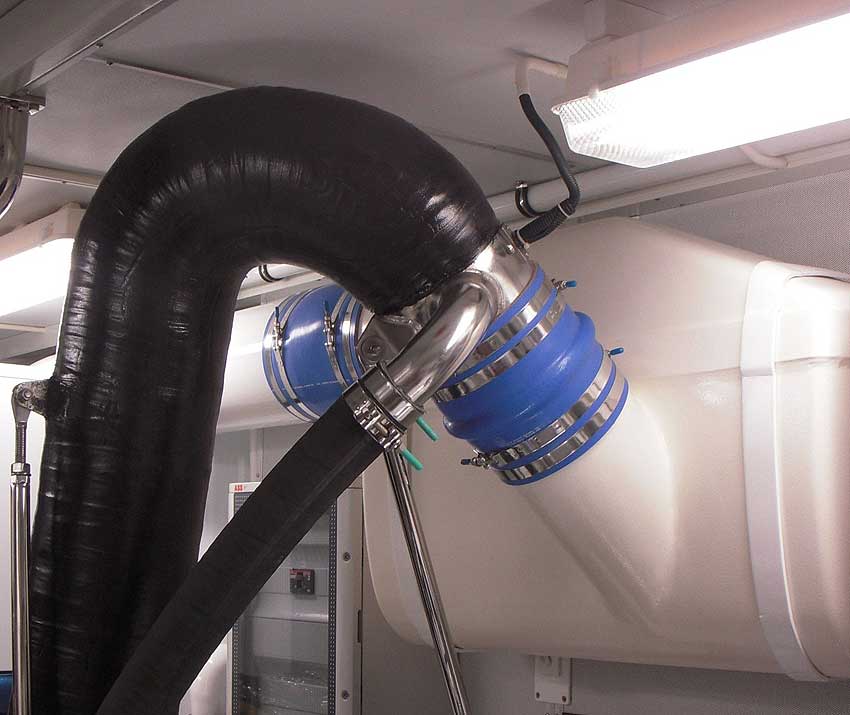
Comparison of Marine Exhaust Types
In this article, we will try to compare the typical exhaust types and application methods, as well as to list their advantages and disadvantages.
Underwater Exhaust Applications
1. Wet Exhaust System
In this type of application, the gas entering the muffler is mixed with the machine cooling water in the mixer after the machine turbo outlet and is transmitted to the muffler in this way. Exhaust gas mixed with water is discharged from under water. In addition, the outflow of gas that cannot escape underwater is expelled by a by-pass line from a point above the waterline level.
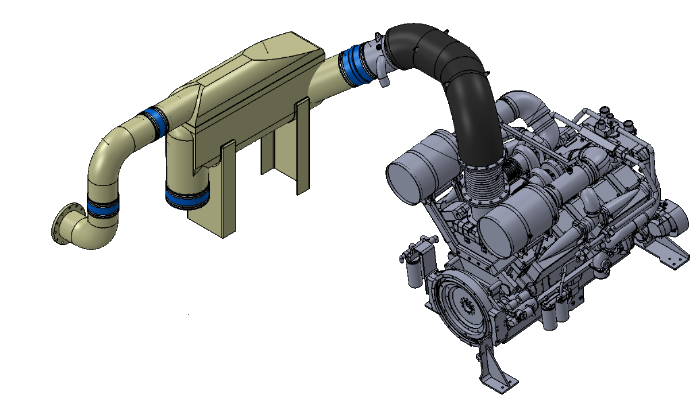
Advantages:
-
Depending on the silencer insulation value, the noise from the by-pass line can be minimized up to a certain cruising speed and machine speed.
-
Due to the fact that the system is cooled down with sea water, heat dissipation from the exhaust system is minimum
-
It is relatively lighter than dry type silencer applications
-
Wet type silencers are smaller sizes with respect to dry type silencers
Disadvantages:
-
It can be said that the cost can be relatively higher than conventional systems. Conventional system refers to the exhaust system which is supplied without silencer and directly under water.
|
|
|
|
2. Dry Exhaust System
In this type of application, the gas reaches the muffler directly after the turbocharger. The gas is cooled in the mixer by machine cooling water after the line leaving the silencer. And the gas is discharged out of the vessel under the water line in a chilled form. In addition, the outflow of gas that cannot escape underwater is expelled by a by-pass line from a point above the waterline level.
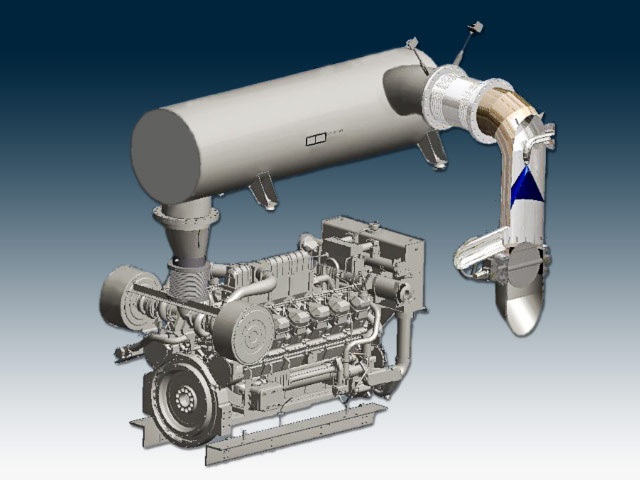
Advantages:
-
Depending on the silencer insulation value, the noise from the by-pass line can be minimized up to a certain cruising speed and machine speed.
Disadvantages:
-
It can be said that the cost can be relatively higher than conventional systems.
-
We can say that the heat dissipation is more than the water-silenced system.
-
External heat insulation is required on dry silencers.
-
Dry-type silencers must be larger than water-type silencers.
In dry-type applications, various types of silencers can be used, but the layout will largely resemble the above image. Sample dry type silencers:
|
|
|
|
3. Silencer-free Systems
In this system, as in the use of dry type silencer or wet type silencer, the dry exhaust gas coming out of the machine is cooled by means of cooling water before it is sent to the water. Although the application examples are rarely seen today, it is not a recommended method that we see in underwater exhaust application methods, since the gas output will be from the by-pass line until a certain speed of the boat and engine rpm, because there is no silencer in the system. In particular, in areas close to the exhaust outlet line, for example stern seating or other living spaces, the exhaust noise will be disturbed.
Above Water Exhaust Applications:
1.Wet Type Silencer
In above water applications, the position of the machine relative to the waterline level is important. The illustration here is for the case where the machines are above the waterline level. In such applications, the exhaust outlet is generally from the transom.

Avantajları:
-
Tekne belirli bir seyir hızına ve makine devrine bağlı kalmaksızın, “susturucu ses izolasyon değerine istinaden”, by-pass hattı mevcut olmadığından dolayı, egzoz çıkış ağzından birlikte çıkan su ve gaz, belirli bir miktar ses izolasyonu sonrasında tekne dışına çıkmaktadır
-
Sistemin sulu olması sayesinde, egzoz hattından ısı yayılımı en azdadır
-
Kuru tip susturuculu uygulamalara istinaden, nispeten hafiftir
-
Sulu tip susturucular, kuru tip susturuculara istinaden, daha küçük boyutlarda olmaktadır
Dezavantajları:
-
Görece olarak maliyetin konvansiyonel sistemlere oranla daha fazla olabileceği söylenebilir
Su üstü sulu tip susturucu uygulaması, su altı sistemlerle kıyaslandığında, yine susturucunun ses izolasyon değerine istinaden, daha az izolasyon yapabilir diye düşünülebilir. Lakin, karşılaştırılan sistemlerde kullanılacak susturucunun tipi, ses izolasyon değerini direkt olarak etkilemektedir, bu nedenle de kesin yargıya varmak için, sistemden beklentimiz ve sistemin ses izolasyon değerleri incelenmelidir.
2. Kuru Tip Susturucu
Su üstü uygulamalarda, kuru tip susturucu kullanımı neredeyse hiç olmamakla birlikte, uygulama mantığı olarak da pek uygun bir uygulama yöntemi değildir.
3. Susturucusuz Sistemler
Su üstü uygulamalarda, yine susturucusuz kullanım neredeyse hiç olmamakla birlikte, uygulama mantığı olarak da pek uygun bir uygulama yöntemi değildir.
SONUÇ:
Yukarıda kısaca özetlemeye çalıştığımız egzoz uygulama yöntemleri, tavsiye etmediklerimiz hariç, diğerlerinden herhangi birisinin kullanılması uygun diyebiliriz. Aynı zamanda, yukarıda ana başlıklarıyla belirtilen sistemler, çeşitli markaların çeşitli susturucu, muffler, lift seperator gibi isimlerle anılan, farklı tip susturucu modellerine istinaden, ufak değişiklikler gösterebilir. Örneğin, susturucunun teknedeki pozisyonu, giriş çıkışlarının yerleri, sistemdeki komponent gereksinimi gibi.
Sistem seçiminde, dikkat etmemiz gereken başlıca unsurlar aşağıdaki gibi sıralanabilir:
-
BÜTÇE
-
SES İZOLASYON DEĞERİ BEKLENTİSİ
-
AĞIRLIK
-
MAKİNE DAİRESİ YERLEŞİMİNİN ELVERİŞLİLİĞİ VE BUNA BAĞLI OLARAK, EGZOZ SİSTEMİNİN DİĞER SİSTEMLERLE İLİŞKİSİ
-
TEKNE TİPİ VE BUNA BAĞLI OLARAK TEKNE SÜRATİ
-
EGZOZ ÇIKIŞ NOKTASININ, YAŞAM ALANLARI İLE OLAN İLİŞKİSİ VE MESAFESİ
-
TEKNENİN TABİ OLDUĞU İNŞAA KURALLARI (CE, RINA, BV, TL v.b.)
